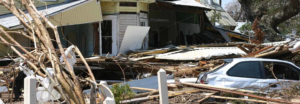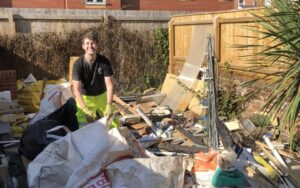Utah Disaster Cleanup helps after natural disasters like floods, hurricanes, tornadoes, or fires. In the first place, make sure that you and your family are safe.
Then, take inventory of your belongings, taking multiple pictures for insurance purposes. You can usually clean many items with hot, soapy water.

Water damage is one of the most common problems that can result from disasters. It can cause serious harm to a building’s structure and contents, leading to mold growth, rotting of wood materials, electrical short-circuiting and more. Water damage can be caused by both natural and man-made sources. Common causes of water damage include plumbing issues like leaking pipes, malfunctioning appliances such as washing machines or dishwashers, and flooding from heavy rains or hurricanes.
The IICRC divides water damage into three categories. Category 1 is clean water that does not pose a health risk to humans, such as water from a faucet or toilet tank. Category 2 is gray water that contains contaminants that can cause illness if ingested, such as water from a washing machine or dishwasher overflow. Finally, Category 3 is black water that poses a threat to human health and life, such as floodwaters or water from sewage backups.
During a disaster, the most important thing is to ensure your family’s safety. Stay away from damaged buildings until local officials say it is safe to return. If you must enter a home with visible damage, turn off the power, gas and water supplies. Make a list of all damages and take photos or video. If possible, remove valuable items and store them in a safe location outside of the disaster area.
Fire is one of the most devastating disasters that can happen to your home. It can cause immense damage in the short time it rages, and it may leave you homeless. It also destroys many of your belongings and can make them unusable. You can reduce the damage caused by fire through prompt disaster cleanup. You will need to take several different steps to reverse the damage and get your house back to normal.
The first step of disaster cleanup is to remove all of the smoke and soot from your property. This is a difficult task, and it should be done with the help of professionals. Inhaling these harmful substances is dangerous, so it is important to work in a well-ventilated area with a mask. You should also avoid eating any food that has been in contact with the smoke.
Once the smoke and soot are removed, the next step of disaster cleanup is to disinfect everything. This includes all surfaces and items that came in contact with the fire, as well as anything that may have been contaminated by water from firefighting efforts. If the affected areas are not disinfected, they can develop mold and cause serious health issues.
After the disinfection process, you will need to replace any items that were destroyed by the fire. This can include furniture, clothing, documents, and even the roof. Keeping an inventory of all of your damaged items will help you to file a claim with your insurance company.
It is also a good idea to keep an inventory of all of your valuables that were kept in the affected area. This will ensure that you get the right amount of compensation for your losses. If you have a valuable item that was lost in the fire, it is crucial to have it appraised by a professional before you purchase a replacement.
If you are cleaning up after a fire, you should not attempt to do any electrical repairs or renovations until the fire marshal has approved it as safe. This is because there could be lingering chemicals in the air from firefighting efforts that are dangerous to handle without proper training. If you are going to clean up the debris yourself, make sure that you wear rubber gloves and safety glasses. It is also a good idea to use a dust mask.
Molds are microscopic fungi that, when they come in contact with moisture and food sources, produce colonies that are spongy, slimy and very dark. Molds grow rapidly and spread through the air as spores. Mold spores are found in every home and can easily get in through open windows, doors or other gaps and crevices. Once inside a house, they can cause structural damage, as well as adversely affect the health of its occupants.
Mold spores thrive in moist environments, such as those created by flooding or leaking roofs and walls. Once inside a building, they can spread and grow in wood moldings, insulation, paper sheathing, carpet and drywall. Molds feed on organic materials and destroy them, so the only way to prevent damage is to remove or replace any affected material.
Depending on the type of mold, exposure to it for an extended period of time may make people sick. Common allergic reactions include watery eyes, runny nose, itching, sneezing, headache and fatigue. Some types of mold produce toxins, called mycotoxins, which can cause more serious illness. People at risk for such illness include infants and children, elderly people, immune compromised patients and those with chronic respiratory conditions.
Although it is impossible to eliminate all occurrences of mold and mildew, prevention is possible by controlling indoor humidity. Ideally, humidity should be kept below 60 percent, and areas that are susceptible to moisture should be kept dry at all times.
If you have a recurring problem with mold growth in your home, call in a disaster recovery professional as soon as possible. They will identify and eliminate the source of moisture, and assess the extent of the water/mold damage. In addition to mold testing and inspection, the restoration team should follow EPA’s guidelines for Mold Remediation in Schools and Commercial Buildings, or other guidance from professional or government organizations.
Disaster restoration professionals should wear personal protective equipment, such as coveralls that protect them from contaminated surfaces and spores. DuPont Tyvek coveralls, for example, have a low-static fabric that blocks airborne contaminants and is breathable and comfortable to work in. Containment poles, such as Trimaco’s Heavy Duty E-Z Poles, also help contain the area to prevent contamination from spreading during cleanup and repair work.
Sewage damage is a disaster that can be both costly and dangerous. It carries pathogens that can make you sick if exposed to it, and it also damages your property. A sewage backup can destroy your carpets, furniture and other porous materials. It can also stain your walls and flooring. Disaster restoration companies are equipped to handle sewage cleanup and repair, and they work within IICRC guidelines to ensure that the job is done correctly.
Floods, severe rainstorms and even the thawing of snow and ice can cause sewer lines to become overburdened and clogged. In addition, aging septic systems can lead to problems. When this happens, it can back up into basements or homes and create a nightmare situation. The good news is that sewage damage can usually be repaired fairly quickly by a disaster restoration company.
One of the most important things you can do to prevent sewage damage is to watch what you put down your drains. Only water and human waste should be flushed down toilets, and other items like grease should go in the garbage can. You should also regularly trim tree roots that grow near your sewer line.
Besides being disgusting to look at, sewage backups can pose serious health risks to you and your family. In fact, the bacteria and viruses in sewage can make you very sick if it comes into contact with your skin or if you ingest it. It is crucial to avoid coming into direct contact with sewage water and to seek medical help as soon as possible.
Dealing with the enormous quantities of debris and waste that are left behind after a disaster is an enormous task for communities and local governments. As disasters continue to happen around the world, it is critical that we develop better strategies for dealing with the waste and the damage they cause. Disaster cleanup shouldn’t be a separate process from disaster recovery and mitigation, but should be incorporated into ongoing development planning and disaster response. By including it in these plans, we can minimize the negative effects of future disasters and disasters on people and the environment.
